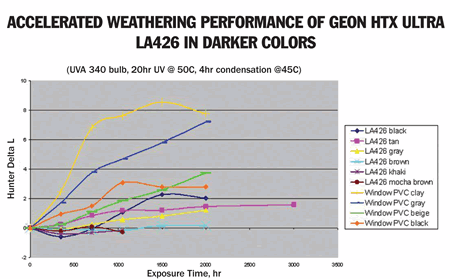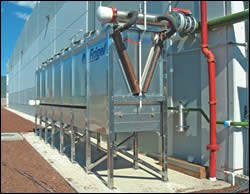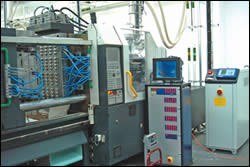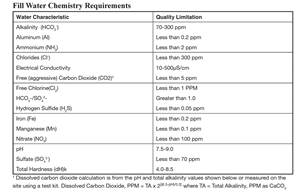Fluid Cooler Offers Alternative to Cooling Towers or Central Chillers
When it comes to cooling extruders and injection and blow molding machines, the vast majority of plastics processors in the U.S. choose cooling towers.
When it comes to cooling extruders and injection and blow molding machines, the vast majority of plastics processors in the U.S. choose cooling towers. For 80 years, cooling towers have been the workhorses of plastics and other industries despite the ongoing expense of water treatment, regular heat-exchanger cleaning, difficult cold-weather operation, and large consumption of water. Some processors have added large heat exchangers to isolate the dirty tower-water circuit and ensure a clean stream of water going to the molds and machines, although it requires extra energy for pumping and the additional heat exchangers sacrifice some efficiency. Still other processors choose air-cooled portable or central chillers, along with their tradeoffs of higher energy use, noise, and heat.
Now there is another alternative to cool the hydraulics, chiller condensers, air compressors, and mold-temperature control units (TCUs)—one that reportedly involves none of the drawbacks of other approaches. It relies primarily on cooling plant water by outdoor ambient air—but inside a sealed, air-cooled heat exchanger with no exposure to the environment, unlike a cooling tower.
Although this approach is little known in the U.S., it is used in some 5000 plants in Europe and Latin America, where water and energy are more expensive and water quality is often lower. It is now being marketed here by a new Chicago-area company, Frigel North America, Inc., a subsidiary of Frigel Firenze S.p.A. of Italy.
Simple, no-hassle system
According to sales/marketing manager Michael Peyser, Frigel’s EcoDry “fluid cooler” system guarantees clean water at 90 to 95 F or cooler all year long, even if outdoor temperatures soar well over 100 F. Peyser (one of a cadre of former AEC employees at the new firm) says this air-cooled heat exchanger channels plant water through “radiator-type” coils where heat is removed by a draft of ambient air induced by large fans with highly efficient brushless, variable-speed DC motors. This approach works for ambient temperatures up to about 85 F.
At higher ambient temperatures, the EcoDry system switches automatically into “adiabatic” mode, which uses a spray of tap water to cool the ambient air. Unlike other systems of this sort, the water is not sprayed directly onto the cooling coils, which would leave behind a gradual buildup of scale. Instead, a fine mist of tap water is sprayed into the incoming air stream inside a chamber below the cooling coils. Spraying takes place as air passes through a honeycomb material similar to cooling-tower fill. The water evaporates instantly, cooling the air before it impinges on the cooling coils that carry the process water. The coils’ fins remain dry (thus Peyser calls this a “dry cooling” system.)
For very cold weather, Peyser says the EcoDry system can use glycol (“antifreeze”) with water—but Frigel generally prefers to use pure water whenever possible because it has the best heat-transfer properties. For cold weather, the EcoDry system has built-in freeze protection that monitors ambient and return water temperatures. In a pure water system, if the leaving water temperature drops below the setpoint, the controller halts the pumps circulating to the outdoor heat exchanger and the EcoDry automatically drains its water back to an indoor reservoir. The central system then circulates cool water from this indoor tank until it becomes sufficiently warmed to permit sending it outdoors again to the heat exchanger.
Peyser emphasizes that this system circulates only clean water. It is a closed-loop system, so there is virtually no water consumption or evaporation (except a small amount external to the heat exchanger for adiabatic cooling on very hot days), and thus no scale deposits and no need for ongoing water treatment.
Frigel’s EcoDry system is said to minimize costs in other ways: It uses only one piping circuit instead of the usual two, and there is no need to insulate the water-distribution piping to prevent sweating. There is also minimal noise and no need for air-conveyance ducts to remove hot air generated by air-cooled chillers. Unlike a tower system, there is no water purging to reduce concentration of dissolved materials and no downtime to clean heat exchangers or pump seals and heaters damaged by contaminated water. What’s more, the outdoor heat exchanger is made entirely of noncorrosive copper, aluminum, bronze, and stainless steel.
Modulating at the press
Peyser says clean ambient-cooled water from the outdoor heat exchanger is sufficient to cool press hydraulics, but water temperature and flow rate for molds requires some fine tuning. A typical central chiller or tower system supplies water at one temperature to all the different processes in a plant. Mold temperatures at the press can be modulated only by throttling the flow rate or using portable chillers and TCUs. Frigel supplements its EcoDry system with its own line of compact, beside-the-press chillers or hot-water TCUs. Frigel offers both TurboGel TCUs for temperature ranges up to 356 F and MicroGel chiller/TCU combinations capable of 30 to 300 F.
Besides supplying water at the optimum temperature for each individual process, TurboGel and MicroGel units are said to offer several advantages over competing units:
- Because they are designed to process only clean water, they can be more compact than otherwise—e.g., with narrower passages and more fins per inch on internal heat exchangers.
- MicroGel units have a reportedly unique and energy-saving three-way valve that provides heating or cooling when required or sends ambient-cooled water from the outdoor heat exchanger directly to the mold when outdoor temperatures are appropriate to the needs of the process.
- An automatic mold-draining feature has proved attractive to a number of molders, Peyser says. It creates a vacuum to suck water out of the mold more quickly and neatly than gravity draining and inevitable spills on the floor.
- A motorized modulating valve (instead of the on/off solenoids used on some units), together with a proprietary software algorithm, is said to enable faster mold heat-up. It allows the system to preheat the cold mold with water a little hotter than setpoint and then quickly and precisely drop back down to the operating temperature when the mold warms up.
Incidentally, Frigel also offers portable chiller-only units, central air- and water-cooled chillers, and pump-tank systems
Related Content
Troubleshooting Leaky Temperature-Control Units
Learn the causes, symptoms and remedies for TCU leaks to keep these vital contributors to plastics processing up and running longer and more efficiently.
Read MoreHow to Reduce Sinks in Injection Molding
Modifications to the common core pin can be a simple solution, but don’t expect all resins to behave the same. Gas assist is also worth a try.
Read MoreTemperature Control Unit (TCU) Modulates Heat Output in Real Time
Delta T Systems’ Smart series water TCU features “Vari-Heat” technology for greater precision and efficiency.
Read MoreTemperature Control Units on Display at PTXPO
technotrans says climate protection, energy efficiency and customization will be key discussion topics at PTXPO as it displays its protemp flow 6 ultrasonic eco and the teco cs 90t 9.1 TCUs.
Read MoreRead Next
People 4.0 – How to Get Buy-In from Your Staff for Industry 4.0 Systems
Implementing a production monitoring system as the foundation of a ‘smart factory’ is about integrating people with new technology as much as it is about integrating machines and computers. Here are tips from a company that has gone through the process.
Read MoreMaking the Circular Economy a Reality
Driven by brand owner demands and new worldwide legislation, the entire supply chain is working toward the shift to circularity, with some evidence the circular economy has already begun.
Read More
















